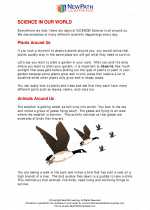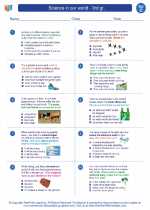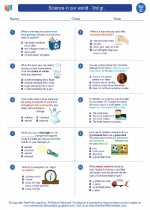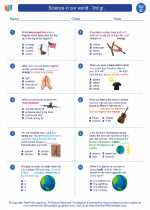Microorganisms
Microorganisms, also known as microbes, are tiny living organisms that are too small to be seen with the naked eye. They include bacteria, viruses, fungi, and protists. Microorganisms are found everywhere - in the air, soil, water, and even inside our bodies.
Types of Microorganisms
- Bacteria: Single-celled organisms that can be found in various environments. Some bacteria are harmful, causing diseases, while others are beneficial and help with processes like digestion.
- Viruses: Small infectious agents that can only replicate inside the cells of other organisms. They cause a wide range of diseases in humans, animals, and plants.
- Fungi: These include molds, yeasts, and mushrooms. They can be helpful, such as in the production of food like bread and cheese, or harmful, causing infections.
- Protists: Single-celled organisms that are more complex than bacteria. They include algae and protozoa, and can be found in aquatic environments.
Importance of Microorganisms
Microorganisms play a crucial role in the environment and in our lives. They are involved in processes such as decomposition, nitrogen fixation, and food production. They are also used in industries like pharmaceuticals, agriculture, and biotechnology.
Study Tips
- Use a microscope to observe different types of microorganisms.
- Research the role of microorganisms in specific industries or environmental processes.
- Learn about the diseases caused by harmful microorganisms and how they can be prevented.
- Understand the importance of microorganisms in maintaining ecological balance.
Now that you have a better understanding of microorganisms, you can explore their fascinating world and their impact on our lives!
.◂Science Worksheets and Study Guides Third Grade. Science in our world - 3rd gr.
Study Guide Science in our world - 3rd gr.
Science in our world - 3rd gr.  Worksheet/Answer key
Worksheet/Answer key Science in our world - 3rd gr.
Science in our world - 3rd gr.  Worksheet/Answer key
Worksheet/Answer key Science in our world - 3rd gr.
Science in our world - 3rd gr.  Worksheet/Answer key
Worksheet/Answer key Science in our world - 3rd gr.
Science in our world - 3rd gr.  Worksheet/Answer key
Worksheet/Answer key Documenting Data
Documenting Data 

 Worksheet/Answer key
Worksheet/Answer key
 Worksheet/Answer key
Worksheet/Answer key
 Worksheet/Answer key
Worksheet/Answer key
 Worksheet/Answer key
Worksheet/Answer key

The resources above cover the following skills:
History and Nature of Science: A student should understand the history and nature of science. A student who meets the content standard should:
Develop an understanding that historical perspectives of scientific explanations demonstrate that scientific knowledge changes over time, building on prior knowledge.
Develop an understanding that scientific knowledge is ongoing and subject to change as new evidence becomes available through experimental and/or observational confirmation(s).